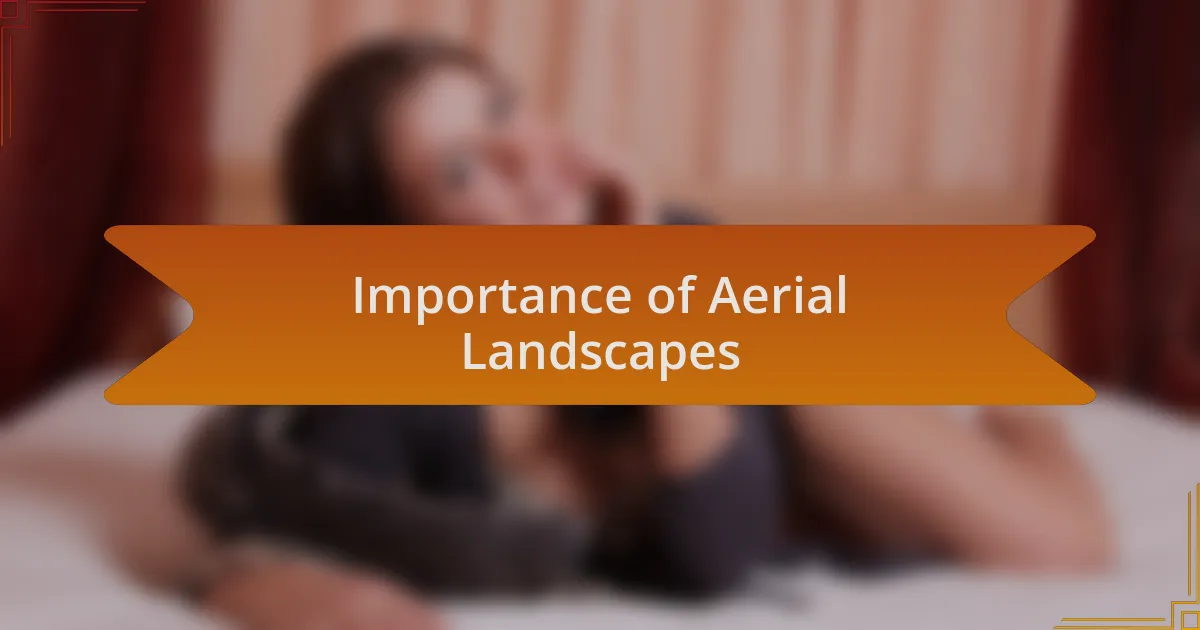Key takeaways:
- Drone mapping uses high-resolution cameras to create detailed, 3D terrain representations, enhancing understanding and conservation efforts.
- Aerial landscapes reveal hidden patterns and human stories, fostering a deeper appreciation for the environment and its complexities.
- Zanzibar’s diverse geography, including lush greenery and sparkling waters, provides stunning visuals, particularly from aerial perspectives.
- Locations like Mnemba Atoll, Kizimkazi, and spice plantations offer unique narratives that connect culture, history, and nature through aerial photography.

Introduction to Drone Mapping
Drone mapping has transformed the way we perceive and analyze landscapes. I remember my first experience with a drone, watching it hover over a stunning vista in Zanzibar, capturing intricate details that my eyes could barely register. It made me realize how powerful and accessible technology has become in documenting our environment.
Have you ever wondered how a simple drone can create stunning, detailed maps? The technique involves using high-resolution cameras to capture overlapping images from different angles. By stitching these images together, we can produce accurate, 3D representations of terrain, enhancing our understanding of geographic features and facilitating better planning and conservation efforts.
From personal experience, I’ve found that aerial maps offer a fresh perspective, revealing hidden patterns in nature that often go unnoticed from the ground. It’s fascinating how these tools can aid not only scientists and planners but also hobbyists like myself. The thrill of capturing and analyzing landscapes from above is not just about the technology; it’s an intimate connection to the world around us, showcasing its beauty in a way that’s both inspiring and profound.

Importance of Aerial Landscapes
Aerial landscapes hold immense importance, as they reveal the intricate tapestry of our environment. I recall a moment during a mapping session in Zanzibar when I spotted a vibrant coral reef from above. It struck me how beautifully the colors contrasted with the surrounding waters, emphasizing the delicate balance of marine ecosystems. How often do we overlook such details while exploring from land?
Moreover, aerial views can serve as powerful storytelling tools. For instance, when I captured an expansive rice paddy field from above, it was not just about the landscape; it showcased the hard work and dedication of local farmers. This perspective can foster a deeper appreciation for our surroundings, as it portrays the human stories intertwined with nature. Have you ever considered how an aerial image can evoke such strong emotions and connections?
In addition, leveraging drone technology for mapping promotes sustainable conservation efforts. Each flight allows us to monitor changes in the landscape over time, providing critical data for preserving fragile environments. I vividly remember documenting a mangrove restoration project—watching the once-barren area transform into a lush habitat from the sky made me realize how proactive we can be in nurturing our planet. Isn’t it fascinating how technology and nature can unite to create positive change?
Overview of Zanzibar’s Geography
Zanzibar is an archipelago off the eastern coast of Africa, composed of two main islands, Unguja and Pemba, and several smaller islets. As I navigated the skies in my drone, the lush greenery of the islands juxtaposed with the bright blue waters captured my heart. I often found myself wondering how such vibrant colors coalesce to form a breathtaking mosaic that tells the story of a unique ecosystem.
The geography of Zanzibar is diverse, with coastal plains, rolling hills, and stunning beaches. I remember one particular flight over the Jozani Forest, where the thick canopy contrasted sharply with the sandy shores nearby. This juxtaposition of lush terrain and coastal beauty made me reflect on the delicate balance between land and sea that defines the islands.
One striking feature of Zanzibar’s geography is its abundance of spice plantations, which have earned the islands the nickname “Spice Islands.” As I soared above the plantations, I felt a deep connection with the rich heritage they represent. The winding paths through the plantations made me ponder how this agricultural landscape is a testament to the islanders’ cultural roots and their relationship with the land. Have you ever felt that connection to a place just by seeing it from above?

Best Locations for Aerial Shots
A few of my favorite spots for capturing aerial shots in Zanzibar include the stunning beaches of Nungwi. As I hovered above the coastline, the contrast of the white sands against the turquoise waters was absolutely mesmerizing. I remember thinking that this view truly embodies paradise, inviting anyone to dive into its beauty.
Another fantastic location is the ancient Stone Town, where the labyrinth of narrow streets and historical architecture come alive from above. The bird’s-eye view reveals a vibrant tapestry of terracotta roofs and bustling markets. I felt an exhilarating rush as I framed the scene, realizing that each corner tells a story that resonates through time.
Don’t overlook Pemba Island as well. One afternoon, while flying over the rugged cliffs, the dramatic coastline unfolded beneath me. The sheer drop into the ocean combined with the rolling hills created a breathtaking landscape that left me speechless. Can you imagine capturing that raw beauty? It’s moments like these that solidify my love for aerial photography in places like Zanzibar.

My Personal Favorite Spots
One of my top spots for aerial shots is Mnemba Atoll. When I flew over this marine paradise, the vibrant coral reefs seemed to stretch endlessly, creating a stunning patchwork of colors. That moment made me ponder how crucial it is to protect such pristine environments. Just imagining the underwater life thriving there really touched my heart.
I also cherish capturing the sunset over Kizimkazi. As the sun dipped below the horizon, its warm colors painted the sky, illuminating the iconic dhow boats gracefully gliding across the water. This experience left me reflecting on the beauty of everyday moments, and I couldn’t help but look forward to sharing this incredible scene with fellow photography enthusiasts.
Lastly, the spice plantations in the central region have a special place in my heart. The lush greenery and aromatic spices create a unique landscape that’s distinctly Zanzibar. While capturing the aerial perspectives, I often found myself lost in thoughts about the rich cultural heritage tied to these lands. Have you ever considered how each aerial shot can tell a story about the land beneath? It’s these narratives that truly inspire my aerial explorations.

Comparison of Different Locations
When comparing the beauty of Mnemba Atoll and Kizimkazi, the experience is quite diverse. Mnemba’s underwater scenery showcases vibrant coral life, inviting a sense of tranquility that resonates deeply within me. In stark contrast, the dynamic energy of Kizimkazi’s sunsets fills me with a mix of nostalgia and excitement, making each flight something uniquely special. Which location captures your sense of wonder more profoundly?
The spice plantations offer an entirely different narrative, rich with cultural heritage and history. The intricate patterns of green fields, seen from above, evoke a sense of connection to the land that I find completely enchanting. Each aerial shot reveals stories of the people who cultivate these spices, prompting me to reflect on the traditions that have flourished here. Have you ever thought about how landscapes can narrate the cultural tales of a place?
All three locations boast striking beauty, yet each ignites distinct emotional responses. While Mnemba Atoll speaks to my love for marine ecosystems, Kizimkazi’s sunsets stir my appreciation for fleeting moments. The spice plantations, with their aromatic allure, remind me of the rich tapestry of life that exists on land. How do these differences shape your perception of Zanzibar?